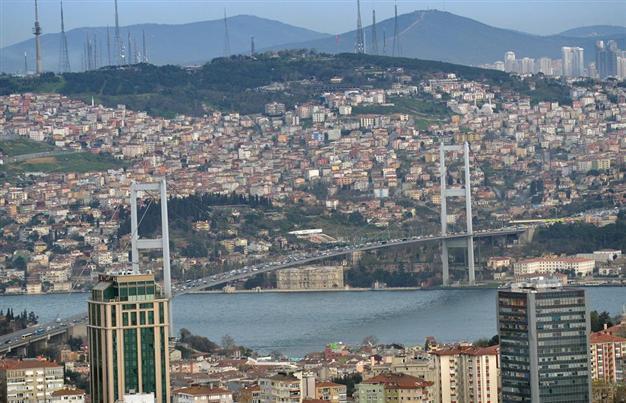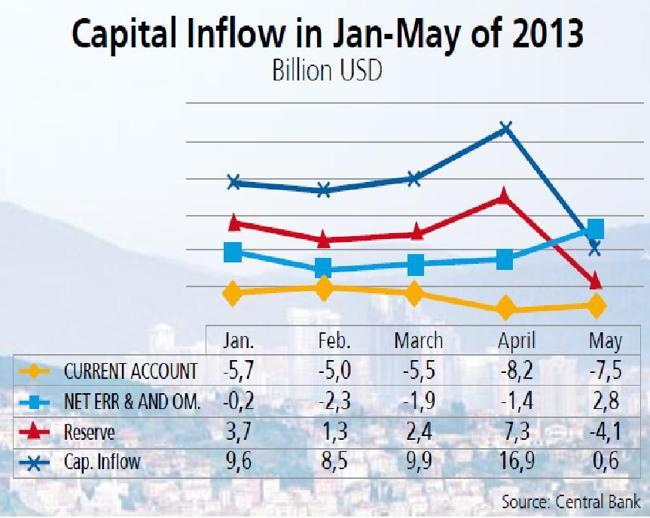End of ‘la dolce vita’ period with foreign capital for Turkey soon
Mustafa SÖNMEZ

Around $400 billion of foreign capital has flowed to Turkey since the end of 2003, a first in the country’s history. The Turkish economy now consumes more foreign currency and is more dependent on foreign capital than ever before. DAILY NEWS photo, Emrah GÜREL
Turkey attracted around $400 billion of foreign money between 2003 and 2012, but foreigners have now stepped back. Amid the current high capital outflows and the plunges in the Turkish Lira, the government appears to be raising the interest rates, although it does not want to do. The Central Bank has already signaled that it could raise the rates by July 23. Turkey is not unfamiliar with the relentless clash between interest rates and exchange rates.
The rise in the foreign capital inflow is known as the most crucial basis of the economic performance of the Justice and Development Party (AKP) for the last decade. However, following the recent announcements by the U.S. Federal Reserve (FED) to end the high liquidity party, to raise rates and to aim at increasing the United States’ growth rate to 2 percent in 2013 and 3 percent in 2014, fairly high amounts of foreign capital started flowing out of emerging markets, including Turkey, by May. This caused losses of value in currencies of the emerging world, up from 5 to 7 percent. The Turkish Lira saw deals at 1.97 against the U.S. dollar in the first half of July, although the annual average value of 1.83 against the dollar has been aimed at for 2013 according to the medium-term program. As long as the Central Bank wanted to rebound the exchange rate by selling dollars, it could not do more than melting down its reserves. Turkey thus experienced a $7.5 billion monthly current account deficit, but a lower than $1 billion of foreign capital inflow in May 2013; an unusual month when the deficit was financed by the central bank reserves and some foreign capital inflow, which has unknown roots.

The same dark picture is also the case in both June and July. We’ll see it clearer when the balance of payments data are announced in the middle of August and September.
The stop in foreign capital inflows to Turkey and the FED’s highly expected move for raising rates to attract capital to the U.S. signals the end of an era in the global markets.
Burhan Karaçam, the former general manager of the Yapı Kredi bank and a banking veteran, is now enjoying his retirement, dealing in agriculture as a hobby. He recently told daily Bugün the following: “It appears a weak possibility to live in the next decade as we did in the previous decade … If the U.S. tapers liquidity, we’ll all see the results. I don’t know how long it takes, but I believe the most sensible move is to extend the terms of loans as much as possible. This, however, is quite difficult to do with existing pricings, creating extra costs. Such a move also increases the inflation rate, to be sure. The ups-and-downs in the exchange rates will also be the case for a while.”
High liquidity, high growthThe apparent acceleration in the foreign capital inflow to Turkey since the end of 2003, just after the AKP came to power, directly hiked many key economic indicators, such as the annual growth rates, employment, foreign trade, etc. The infrastructural background for welcoming such high amounts of foreign money, however, was built during the (57th) coalition government between 1999 and 2002, just before the AKP came to power.
High amounts of foreign capital had flowed for the privatization tenders of the (Turkish) state economic enterprises, and the sale operations of local banks (mainly to Europeans) in Turkey since 2003. The national stock exchanged really loved the highly rated state bonds. A majority of the money, however, was attracted by private banks and the non-financial sector as loans.

Around $400 billion of foreign capital flowed into Turkey between 2003 and 2012. The highest inflow, $70 billion, was seen in 2012. $47 billion of this money was used to finance the annual current account deficit of that year, while the remaining amount was used to reinforce the central bank reserves. Yes, it was unusual to raise the Central Bank’s reserves with that (borrowed) money, but the AKP government would have known that reinforcement would be needed in the coming rainy days.
It appears to be helpful to compare the balance of payments of the AKP era with that between 1980 and 2002 to understand how high amounts of money flowed into Turkey during the period of the AKP government. While no more than $35 billion of foreign capital flowed into Turkey in the 22 years from 1980 to 2002, this amount increased around 10-fold during the AKP era.
Money came, but what happened next? What did the AKP government do with the foreign capital, 10 times higher than Turkey had attracted from 1980 to 2002? Turkey saw an annual growth rate of 4.6 percent between 2003 and 2012.
What was problematic here was the nature of this growth. As foreign money was used to grow more by mainly focusing on the domestic market, the gap between Turkey’s exports and imports widened considerably. The historically high foreign capital inflow was not used properly, not creating a “foreign currency attracting” economy over the last decade. The Turkish economy is now consuming more foreign currency and is more dependent on foreign capital than ever before.
When the money flow stops…How could the Turkish economy, which has lost most of its foreign currency producing abilities, recreate itself if no more foreign capital flows? How could Turkey import more energy resources, which constitute 25 percent of the country’s total imports? How could Turkey meet the deficit? Amid the current high capital outflows and the plunges in the lira, the government appears to be raising the interest rates, although it does not want to do. The Central Bank has already signaled a rise in the rates by July 23. Turkey is familiar with the relentless clash between interest rates and exchange rates. Turkey has previously seen many times when the economy was cooled down, growth slowed, and unemployment surged, just after periods of relentless clashes between interest rates and exchange rates. It appears to be the last thing, but when the economy is so bad it is not easy to change for the AKP government, which is entering a three-year period of three elections: A local election, a presidential election, and a general election.

